Whenever I have free time, I usually spend it doing research on some aspect of the Middle Ages; this mostly falls into the more specific topic of furniture and furnishings of that time period. I study by examining pictures, reading books, and occasionally going to museums. (I would love to go more often, but time and budget affect that possibility considerably.
In preparing my recent
post on the topic of stools in the Middle Ages, I came across a picture of a stool depicted in an 11th century ivory plaque from Salerno. I was intrigued by this picture, so I did a bit of investigation and found a book written on these ivories, and their history and cultural context, as understood by Robert Bergman, after he had conducted several years of research and study on them. In fact, the book I bought,
The Salerno Ivories, was an outgrowth of his thesis on the topic.
In this posting, I want to examine the furniture depicted in these fascinating little ivory panels; in a future post I will compare these depictions with other artwork and actual objects which I believe are of the type depicted herein. I took all the pictures from my book, and have mostly only shown the furniture; should you want to see the rest of the ivories, I suggest you buy the book, as I did.
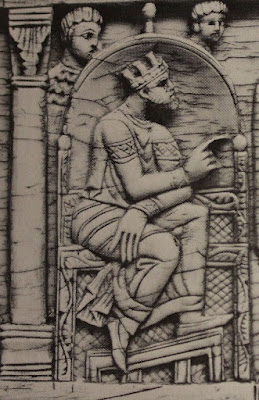 |
| A throne chair and a foot stool |
The furniture type which is most frequently depicted is the
throne chair, for more of which, see
this article. There are no two chairs depicted alike, even if the same person is portrayed sitting on them (which is only the case with King Herod).
 |
Adoration of the Magi; another throne chair
and its surrounding baldachin |
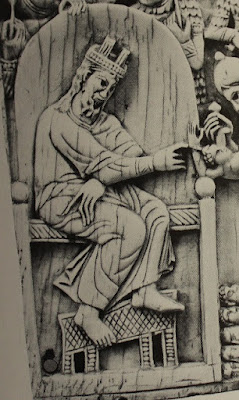 |
| King Herod, from the Massacre of the Innocents |
 |
King Herod again, this time visited by the
Magi. Notice the differences in this throne. |
There are also, featured in one of the panels, a stool, a bed and a small table. In a previous post I pointed out, and will do so again here, that the bed is not a large platform supported by four spindly legs in its centre, as a literal interpretation of this picture might suggest. The artist was not concerned with depicting things as we see them, but was only interested in compositional harmony and rhythm. He had an interest in showing the turned legs for the bed, but had he carved the scene in a more realistic manner, the legs would be almost completely concealed by the seated figures, besides the fact that he seems to have wished to use the four upright legs as part of the vertical elements of his layout.
 |
| Here is the original picture that sparked my interest in this topic |
Another type of seating which has several representations is the
plinth chair, which you can read more about
here.
 |
In the scene of Pentecost, the disciples are depicted either sitting on plinth
chairs or one long 'plinth bench', the end of which is portrayed on the
right of the plaque. Each figure has his own foot rest. |
 |
Three more plinth chairs and a round table
(my apologies for the sideways picture, sometimes
Google does this and I cannot figure out how to
correct it.) |
Several other pieces of furniture depicted in the ivories are beds. I have shown four here, and there are actually a couple more in the series, but the details are not clear enough to be worth including them here.
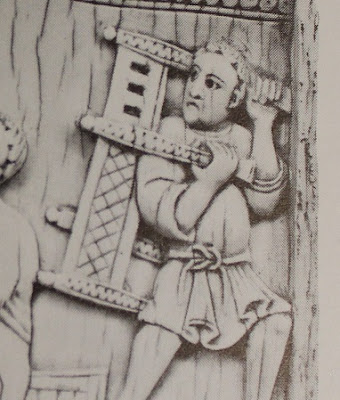 |
| The healed paralytic carrying away his bed |
 |
| Noah asleep in his bed, after having gotten drunk. |
Here is an example of medieval artists not being overly concerned with the details of the story whilst carrying out their creations. In the story of Noah, he was found naked and drunk, but here he is clearly already clothed before his son drapes the cloak over him. Medieval artwork is almost never to be interpreted as accurate depictions of anything, even if it may offer some visual clues.
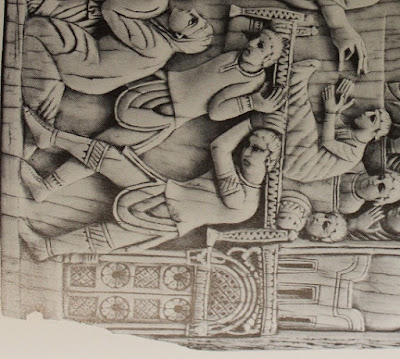 |
Another(again, sideways pictured) bed, This one with decorative
turned legs and flared feet
Compare the detail of the doors in this picture with those in the above
picture of King Herod Visited by the Magi |
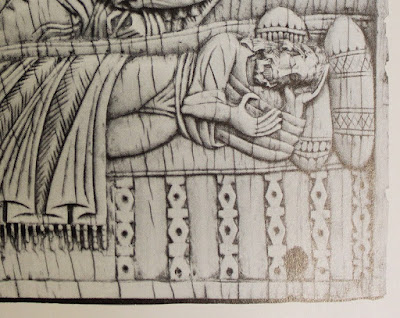 |
| St Joseph dreaming in a bed with bobbin and reel turned sides |
And so that is nearly all the panels which have any meaningful depictions of furniture in them, but I want to put one of these pictures here a second time, in case you did not catch the other piece of furniture in it the first time.
 |
| A bottle of wine in a cabinet |
Here is depicted a small bedside cabinet, with Noah's wine flagon inside. I believe it is intended as a cabinet because of how it is depicted, but I am also aware of a series of Old Testament fresco illustrations in a church in Italy which have similar cabinets beside Abraham's bed; thus giving me additional reason to believe what is pictured here is a cabinet. In one of those paintings, the doors of the cabinet are shown ajar. When I do the second half of this blog topic, I will share that picture for your own comparison.
I have often spoken about the level of detail depicted in the objects portrayed in artwork, as compared to actual decorations of objects, and the fact that artwork almost never shows the true extent of actual ornamentation. No better example of my point can be found than in the following set of pictures of ornamental fragments which originally framed these ivory plaques that we have just examined.
It is the theory of Robert Bergman, who spent several years studying these ivories, that these panels were originally part of a set of doors. As such, these ornamental bands would have formed the framework to the door panels. By looking at these decorative strips, we can get a better idea of the ornament which could have been used to decorate the sides of beds and chairs, or the legs of tables and cabinets. The remains of at least three medieval chairs, all older than these 11th century ivories, still exist, and all of them have the same degree of carved ornamentation to their structural elements. All of the decorations in the portrayed furniture are merely 'X's', zick-zacks, hatching, and dots, but this is due to the small scale of the carving. All of these ivory panels are only 90-120mm wide and to depict any accurate detail of a piece of furniture which is in an area of only 10 or 15mm would be nearly impossible, as well as being pointless. The people for whom these panels were made, already knew what beds, stools, chairs, cabinets, and tables looked like; it is only us, some 1000 years later who clamour for more information.
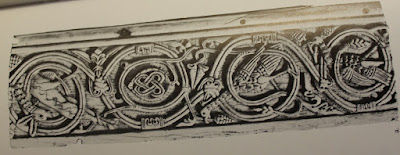

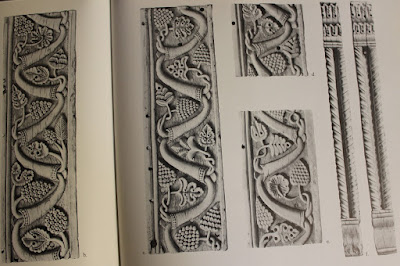
 |
| Several sections of ornamental carving which belong to this set of ivories |
Videre Scire






